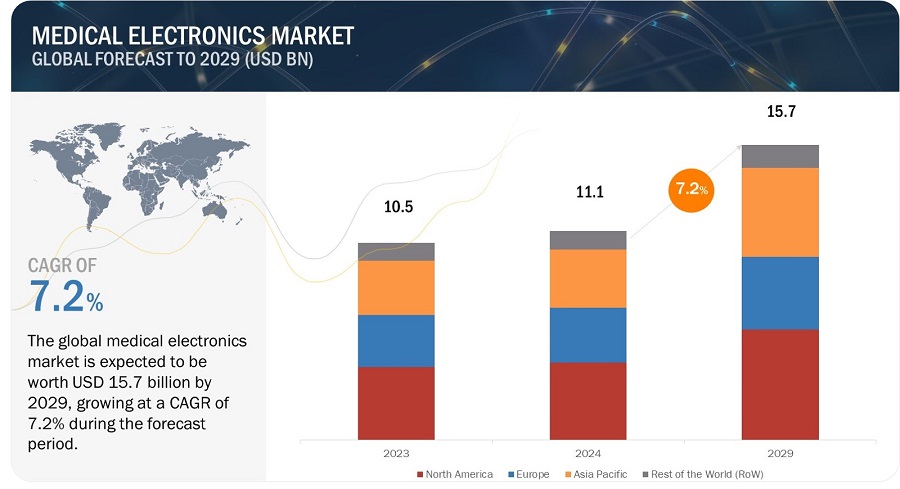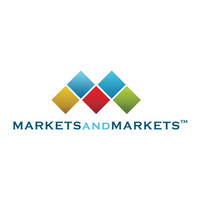
The report “Medical Electronics Market by Component (Sensors, Batteries, MPUs, Displays, Memory Chips), Equipment (Diagnostic and imaging, Patient Monitoring, Medical implantable, Ventilators & RGM, Medical Robots) Device Classification – Global Forecast to 2029” The global medical electronics market is expected to be valued at USD 11.1 billion in 2024 and is projected to reach USD 15.7 billion by 2029; it is expected to grow at a CAGR of 7.2% from 2024 to 2029. Increasing demand for medical devices for patient monitoring and diagnostics is fuelling the growth of the medical electronics market.
Download PDF Brochure @ https://www.marketsandmarkets.com/pdfdownloadNew.asp?id=104528355
Browse 159 market data Tables and 70 Figures spread through 264 Pages and in-depth TOC on “Medical Electronics Market”
View detailed Table of Content here – https://www.marketsandmarkets.com/Market-Reports/medical-electronics-market-104528355.html
Sensors segment based on components in the medical electronics market to grow with the highest growth rate.
The highest surge of growth in medical electronics is due to sensors, which play a crucial role in improving the functionality and accuracy of a wide range of medical equipment. Sensor technology has also been advanced through improved sensitivity, miniaturization, and integration with wireless and IoT systems to extend their use in diagnostics, patient monitoring, and therapy devices. Sensors are increasingly being adopted because there is increasing demand for real-time health monitoring, driven by the rising prevalence of chronic diseases and the shift towards preventive healthcare. Furthermore, the rapid growth in this segment has been fueled by the proliferation of wearable health devices and remote patient monitoring solutions that depend significantly on multiple types of sensors, i.e., temperature, pressure, ECG, and glucose sensors. The continuous innovation and rise in applications alongside sensor technology have resulted in the greatest increase rate within the medical electronics market.
Patient monitoring device segment based on equipment/ device type to hold a larger share in the medical electronics market.
The largest market share of the medical electronics market is taken by patient monitoring devices. This results from the need for continuous and real-time health monitoring, such as managing chronic diseases and critical care patients. With the rising cases of conditions like heart conditions, diabetes, and respiratory problems, there is a need for regular monitoring that will help in better management and mitigation of health risks. Technological advancement has resulted in the development of user-friendly, non-invasive, and sophisticated monitors capable of tracking vital signs such as blood pressure, glucose levels, and heart rate, among others. Additionally, the trend towards home healthcare services and the use of telemedicine has increased the demand for remote patient monitoring solutions, hence allowing physicians to track their patients’ well-being even from a distance. All these are intended not only to improve patient outcomes but also to minimize readmissions back into hospitals to lower costs incurred in healthcare provision, thus making patient monitoring devices a more entrenched player in the medical electronics market.
Minimally invasive medical procedures are expected to exhibit the highest growth in the medical electronics market.
In the medical electronics market, minimally invasive procedures are predicted to have the highest CAGR due to their significant advantages over traditional surgical techniques. Such methods often have more minor cuts, leading to lesser pain, less scarring, faster recovery, and shorter hospital stays for patients. Minimally invasive approaches have become even more efficient and widely available with advancements in medical technology like improved imaging systems, robotic-guided surgeries, and precise surgical instruments. The quick adoption of these surgeries is also fueled by increasing patient preference for less invasive treatment options and healthcare providers’ need for better surgical outcomes at lower costs. Additionally, through continuous development and integration into technological platforms, more effective accuracy and success rates in minimally invasive surgeries are enhanced by AI innovations, 3D imaging technology, and advanced sensors.
Hospitals & clinics medical facilities to dominate the medical electronics market over the forecast period.
The medical electronics industry is led by hospitals & clinics because they offer extensive healthcare services besides investing in state-of-the-art medical technologies. Diagnostic imaging systems, patient monitoring devices, robotic surgery, and therapeutic equipment are among the medical electronic devices found in these health centers that ensure excellent care for numerous diseases. Many patients visiting hospitals and clinics require dependable and effective medical electronics for operational efficiency, successful treatment results, and high healthcare demands. In addition, consistent technological advancements, as well as substantial investments in healthcare infrastructure, facilitate the acceptance and amalgamation of medical electronics in these environments, which make them remain at the top when it comes to this market’s competition.
North America region to exhibit high CAGR in the medical electronics market during the forecast period.
North America Region holds the largest share of the medical electronics market due to advancements in healthcare infrastructure coupled with increasing adoption of novel medical technologies. The region has a strong focus on the R&D of medical devices associated with higher healthcare expenditure. The development of the medical field is backed by various investments from public and private entities. This results in growth in innovation across the medical sector. Furthermore, the aging population across this region is driving the development of the market. Medical devices are being adopted to manage chronic conditions and support elderly care. Such factors are fueling the growth of the medical electronics market in the North American region.
Key Players
The medical electronics companies includes significant Tier I and II players like Analog Devices, Inc. (US), TE Connectivity (Switzerland), Texas Instruments Incorporated (US), STMicroelectronics (Switzerland), NXP Semiconductors (Netherlands), Infineon Technologies AG (US), SAMSUNG (South Korea), Semiconductor Components Industries, LLC (US), Renesas Electronics Corporation (Japan) and others. These players have a strong market presence in medical electronics across various countries in North America, Europe, Asia Pacific, and the Rest of the World (RoW).
Media Contact
Company Name: MarketsandMarkets™ Research Private Ltd.
Contact Person: Mr. Rohan Salgarkar
Email: Send Email
Phone: 18886006441
Address:630 Dundee Road Suite 430
City: Northbrook
State: IL 60062
Country: United States
Website: https://www.marketsandmarkets.com/Market-Reports/medical-electronics-market-104528355.html

